
Caracal (Photo: Mindy Stinner, Conservators Center, Inc)
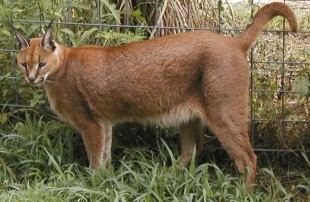
Caracal (Photo: Mindy Stinner, Conservators Center, Inc)
SMALL WILD CAT SPECIES
Most people are relatively familiar with the big cats of the world (lion, tiger, puma, leopard, snow leopard jaguar, cheetah, lynx), but there are a large number of small wild cats, closer in size to our domestic cats.
CURRENT FELID CLASSIFICATION
There are 2 main schools of taxonomy - lumpers and splitters. In simplest terms, lumpers like to lump species together into fewer genera based on shared traits. Splitters like to split genera into multiple sub-genera or species (and species into sub-species) based on small differences. Until recently, classification was based on analysis of physical features to determine which species belonged where; with the pitfall of convergent evolution muddling the results. Recent DNA studies are giving a more precise picture of relatedness of species. As a result there are often several alternative taxonomies at genus, species and sub-species level! The following table is therefore a compromise.
|
GENUS |
SUB-GENUS |
EXAMPLE SPECIES |
|
Felis |
Felis |
European Wild Cat |
|
Lynx |
Lynx |
European Lynx |
|
Neofelis |
Clouded Leopard |
|
|
Pardofelis |
Marbled Cat |
|
|
Acinonyx |
Cheetah |
|
|
Panthera |
Uncia |
Snow Leopard |
|
Unknown |
Onza |
African Golden Cat
(Profelis/Catopuma aurata)
The African Golden cat is about twice the size of a domestic cat. It inhabits the tropical rainforests of equatorial Africa and has also been found in dry tropical forests and savannah grasslands. The African Golden Cat is heavily built with stocky, long-legs, large paws and a long, black-tipped tail. Its rounded heads appears small in relation to its body size. There are two colour forms: the red form (golden to rusty brown) and the grey form plus melanistic (black) forms. They can also be spotted or non-spotted. Spotting, where present, ranges from faded tan to heavy black in colour; the pattern of spotting varies between the two subspecies of African Golden Cat.. They prey on small mammals, small antelope, birds and will also take small monkeys and domestic poultry and livestock..
Andean Mountain Cat
(Oreailurus jacobita)
About the size of a domestic cat, the Andean Mountain Cat inhabits the high South American Andes Mountain range in Chile, Argentina, Peru, and Bolivia. Very little is known about their habits. They are found in the cold, dry and windy treeless terrain at very high altitudes (10,000 ft [3000 m] above sea level). The Andean Mountain Cat is silvery grey with darker grey ticking on its back and pale underparts. It has fine, very long hair forming a thick, soft coat. Its thick tail is banded with dark brown and its body has spots that run in diagonal lines; these are black on the legs, brown on the body, and orange on the back. It is believed to hunt chinchillas and viscachas and possibly small birds and reptiles.
Asian Golden Cat / Temminck's Golden Cat
(Profelis/Catopuma temmincki)
About twice the size of the domestic cat, Temminck's Golden Cat was once believed to be an ancestor (through hybridisation) of the Siamese cat. An agile climber, it inhabits tropical and sub-tropical forest and deciduous woodlands in southeast Asia. They are usually golden brown, greyish, or reddish brown with brown stripes on their cheeks and black markings on their foreheads; not all have spots. Melanistic (black) forms also occur; one was exhibited at Basle zoo in Switzerland. They are opportunistic feeders and eat muntjac, rats and snakes.
Black Footed Cat
(Felis nigripes)
One of the smallest cats (5 lb / 2.3 kg) with males being one third larger than females. They are found in semi-desert and arid brushland in southern Africa. As their name suggests, they have black markings on their paws and the soles of their feet. Their fur is yellowish brown with black bars extending across their shoulders, legs, and on their short tail. They eat small rodents, small reptiles, birds, eggs, invertebrates (spiders, insects) and carrion, but these aggressive and tenacious cats will attempt much larger prey. Its habit of eating carrion makes them vulnerable to poison bait laid for jackals.
Bobcat
(Lynx rufus)

An adaptable North American cat found in a variety of habitats and able to tolerate living near to humans. It is closely related to the Lynx, but only half the size and is considered more aggressive and harder to tame. It has been hybridised with domestic cats. Its black ear tufts and its ruff are less prominent than those of the Lynx and its short tail lacks a black tip. The colour ranges from light grey to reddish brown, though melanistic, albino (blue-eyed white) and leucistic (dark-eyed white) Bobcats have been found. It has black spots on the legs and black markings on the face (black-nosed Bobcats have been reported). Bobcats are opportunistic feeders taking small mammals (especially hare), birds, carrion and any almost other creature they can catch, including domestic poultry. Bobcat are killed and eaten by larger North American wild cats: Jaguar, Lynx and Puma. (Photo: Mindy Stinner, Conservators Center, Inc)
Bornean Bay Cat / Bay Cat
(Catopuma badia)
Found only on the small Indonesian island of Borneo where they inhabit limestone rock that borders forests and in the jungles. They resemble small Asian Golden Cats and have two colour forms: reddish brown and grey. The paler underparts have dark spots and the forehead and cheeks are marked with pale lines. Its teeth are also unusual, with the first upper premolar being reduced in size (in evolutionary terms, this tooth may be on its way to being lost). It is rarely seen and almost nothing is known of its habits. It probably feeds on small mammals, monkeys, birds and carrion.
Canadian Lynx / North American Lynx
(Lynx canadensis)
The Canadian Lynx inhabits forested regions of Canada and the more northern states of the USA. It is about half the size of the Eurasian Lynx and twice the size of a Bobcat. It has a huge ruff and characteristic black ear tufts, long legs, large paws and a short black-tipped tail. The coat is reddish, tipped with white and it may have ghost spotting. A pale grey, almost white, form also occurs and is known as the Blue Lynx. It preys almost exclusively on Showshoe Hare and suffers population crashes when the Showshoe Hare's population periodically drops. Although it will supplement its diet with small rodents, red deer and ptarmigan, it appears to be too highly specialised to switch to alternative prey when Snowshoe Hare populations are in decline.
Caracal / Desert Lynx
(Caracal caracal)
|
|
|
The caracal ranges throughout sub-Saharan Africa and the Arabian peninsula. They are found in arid country i.e. woodland, savannah, steppes and acacia scrub, but not in rainforest or desert. Its most prominent feature is its long (2 inch) black ear tufts. It is smaller than a Lynx and has short, reddish-brown fur with no markings. Melanistic (black) forms occur. A greyish form occurs in Israel. It is slender with a short tail (longer than the Lynx) and no ruff. Its diet includes birds, small mammals and antelope fawns. They will jump to catch birds and will take small livestock such as goats. They are agile climbers and have been known to take their prey up a tree to avoid it being stolen. They can be tamed and trained to chase and catch prey. In captivity, they have been hybridised with Servals (creating Caravals and Servicals) for the pet market and there is one documented case of hybridisation with a domestic cat.
Chinese Mountain Cat / Chinese Desert Cat
(Felis bieti)
Approximately the size of a domestic cat, the Chinese Mountain Cat inhabits the steppe and mountain regions of south-western China and north-eastern Mongolia. It was formerly called the Chinese Desert Cat, but does not occur in the desert; the confusion was due to misidentification of Asian wildcats (Felis sylvestris ornata) as Chinese Desert Cats. It has thick, dense yellowish-brown fur with darker fur on its back and a black-tipped tail ringed with dark bands. It has furry paw-pads and short ear-tufts. Little is known of its habits in the wild. It seems to be solitary, living in burrows and appears to rely on hearing for locating prey. It hunts small mammals, especially mole rats and pika, and birds. It is believed to be closely related to the Jungle Cat (Felis chaus) and the Wild cat (Felis silvestris), but it is not known if it will interbreed with domestic cats.
Clouded Leopard
(Neofelis nebulosa)
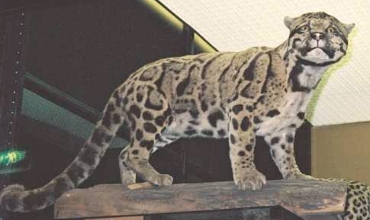
The Clouded Leopard is not a small cat, but the smallest of the big cats and different enough from other cats to have its own genus. It inhabits tropical rainforests in lower altitudes of southeast Asia and is arboreal. It has the body size and shape of a small cat, but the teeth and skull structure of a big cat. It is long-bodied and stocky with short legs, large paws and a thick, long tail almost as long as its body. It has a rounded head with a long muzzle. Clouded Leopards are brownish to rich gold in colour, marked with huge, dark blotches, hence the name "clouded" (the Latin name means "fogged"). The face has dark spots with two black bands running across their cheeks. The ears are short and rounded. Unusually for a cat, the pupil of the eye is oblong rather than slitted or rounded. They have the longest canine teeth relative to body size of any living cat with a large gap between the canines and premolars to enable them to take large bits out of their prey. It is an opportunistic feeder, taking monkeys, orang-utans, deer, wild pigs and fish. Prey is ambushed; the Clouded Leopard hangs from trees by its hind legs falls on it. On the ground, its short legs make it rather clumsy.
Eurasian Lynx
(Lynx lynx)
|
|
|
The Eurasian lynx inhabits forest and scrubland regions of western Europe, Scandinavia, Russia, Mongolia, Manchuria, Iran, Iraq, and Asia minor. They used to be more widespread and conservationists want to reintroduce it to France, Switzerland and Italy (a move opposed by livestock farmers). It is about twice the size of the Canadian/North American lynx. It is yellowish brown to a reddish grey, with black spots and black markings on the face and paler underbelly. It has a large ruff, long black ear-tufts, large feet and a short black-tipped tail. Eurasian Lynx from colder regions are only lightly spotted; those from other regions have lighter spotting in winter. It takes a wider range of prey than the Canadian Lynx: rabbits, hares, deer and reindeer and will also take livestock. In regions where the main prey is Arctic Hare, their populations fluctuate due to fluctuations in prey availability.
Fishing Cat
(Prionailurus viverrinus)
The Fishing Cat occurs in India, China, Vietnam, Thailand, Sumatra and Java, inhabiting areas where there are fresh-water streams and rivers, usually those covered by reeds, swamps, mangroves and marsh. It resembles the Civet, hence the name "viverrina" and is a sturdily built, strong-looking powerful cat with a short broad muzzle, strong jaws, very small rounded ears, rounded head and thick neck. They have short, sturdy legs, a short thick tail and heavy-set body. The front toes are webbed and the front claws do not fully retract; adaptations to catching fish. It is greyish-brown with black bars running along their neck and face, and dark brown spots in rows on their body. It eats mostly fish, but will take frogs, crustaceans, birds, small mammals and carrion. It generally fishes from the shore, scooping the fish out, but will dive for fish. They have a reputation for ferocity (a large male escaped from its cage and killed the leopard in an adjacent cage) and have been blamed for carrying off babies. They have been kept as pets and are currently being hybridised with domestic cats to create the Machbagral and Viverral
Flat Headed Cat
(Prionailurus planiceps)
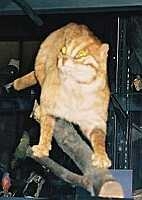
The uncommon Flat-Headed Cat (left)inhabits low-lying tropical forest and scrubland of the Malay peninsula, Indonesia, Sumatra and Borneo, in areas near water. It has a broad, flat head with very small low-set ears (similar to the Manul/Pallas's Cat). It has very large eyes, short legs and a short thick tail. It is reddish-brown, with white underparts, and has thick, soft fur. The flanks and belly are brown-spotted. Two white stripes run from the sides of the nose towards the forehead. Young Flat-headed Cats are more greyish, turning reddish-brown at about a year old. Flat headed Cats cannot fully retract their claws. They also have unusual teeth - all their teeth are pointed, not just the canines. They mostly eat fish, frogs and water animals (the teeth, claws and general shape being adaptations for this), but will take domestic poultry, eat fruit and unearth roots. Very little is known of their habits.
Geoffroy's Cat
(Oncifelis geoffroyi) (Right)
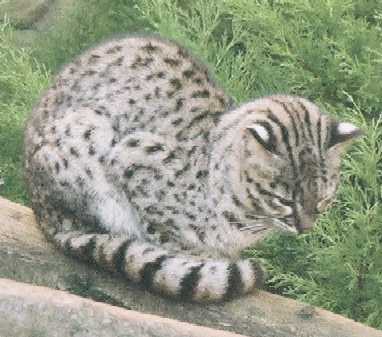
The Geoffrey's cat lives in wooded and scrub regions of Bolivia, Argentina, southern Brazil and Paraguay in South America. It is a little larger than a domestic cat and is golden yellow with black spots all over. The face is marked with black bars running from the corner of the eyes and mouth to the ears, and vertically on the forehead. Melanistic individuals have been reported. Geoffroy's Cat has relatively large eyes set low on the face, making its head look wider than it really is. It hunts small birds, lizards, insects and rodents. Geoffroy's Cats are arboreal, hunting and sleeping in trees. They can be tamed and have been crossed with domestic cats to create the Safari breed, a large, spotted wild/domestic hybrid. Some Geoffroy's Cats found in the vicinity of humans are reported to be hybrids with domestic farm cats.

Iberian Lynx / Spanish Lynx
(Lynx pardinus) (LEFT)
The Iberian, or Spanish, Lynx inhabits wooded areas of the mountains in southwest Spain. There are scattered populations in Portugal. It resembles the Eurasian Lynx, but is about half the size, lighter in colour and has more noticeable spots. In common with other Lynx species, it has a ruff (sideburns), black ear tufts, wide fet and a short, black-tipped tail. It preys mostly on rabbits and hares, but will take fallow deer fawns, ducks and fish. It is endangered due to catastrophic crashes of European hares and rabbits through introduced diseases.
Iriomote Cat
(Prionailurus bengalensis iriomotensis)
Discovered in 1967, the Iriomote cat is found on the 113 square mile (292 sq km) Iriomote Island of Japan, south of Japan and just east of Taiwan. It inhabits a wide variety of habitats on the island, ranging from wooded mountainous areas to open country, and even beaches. It is similar in size to a domestic cat. It is built low (for moving through underbrush), with dark brown with horizontally aligned rows of darker brown spots, small rounded ears and a dark-ringed thick, bushy tail. Its claws do not fully retract and it has slightly webbed feet; unsurprisingly it swims well and can catch fish. It relies mainly on sight for hunting and as well as fish, it takes birds, rodents, fruit bats, reptiles, amphibians and crabs. It is preyed upon by venomous snakes. . It was originally considered a subspecies of Leopard Cat in common with the Tsushima Cat found in the same area. It shares structural similarities with the Marbled cat and the Golden Cats, skull similarities with the Leopard Cat and some similarities with the big cats. It has not yet been established whether it is a separate species.
Jaguarundi
(Herpailurus yaguarondi)

The Jaguarundi ranges from the coast of Mexico, throughout Central America, northwest Argentina, Peru and Paraguay with a small population as far north as Texas, USA. They inhabit lowland areas: swamp, forest and scrub and avoid the open countryside. Its name is from the German for weasel-cat, referring to their otter-like appearance. The Jaguarundi has an almost round head, small semi-circular ears, round eye pupils and short muzzle. It has a long body, short stocky legs and long, slender tail. The fur is short and sleek, ranging from greyish to reddish brown. It is unspotted. There are two colour phase: the greyish phase was known as the Jaguarundi, while the reddish phase was known as the Eyra and believed to be a separate species. The round eye pupils suggest common ancestry with big cats. It mainly hunts during the day and takes small mammals and birds (including domestic poultry), supplementing its diet with fruit. Despite its low-slung build it is an agile cat; it is mostly terrestrial but will climb trees. For centuries, they have been tamed and kept as pets by native South Americans, when content they will purr and chirrup. It is currently in decline, possibly due to habitat loss or because they frequently prey on poultry.
Jungle Cat / Swamp Cat / Reed Cat
(Felis chaus)
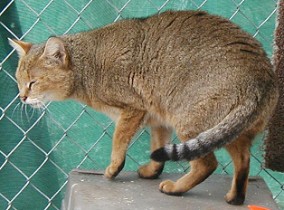
A little large than the domestic cat, the Jungle Cat is found in the jungles and swamps of Egypt, around the Russian Caspian Sea, Afghanistan and parts of Asia and southeast China. Northern Jungle Cats are greyish-brown, while southern races are a tawny colour. They have ticked fur with barred markings on the face and legs and dark-tipped ears. They prey on small mammals, including hares and deer fawns, snakes, frogs and large birds such as pheasants. They can leap high in the air to snatch birds taking off and were trained by ancient Egyptians to hunt water fowl. Their similarity of colour and markings to Abyssinians has led some to believe they hybridised with F silvestris lybica during the evolution of domestic cats. In more recent times they have been hybridised with domestic cats to create the Chausie breed and with European Wild Cats to create the Euro-Chaus, an exotic pet. (Photo: Mindy Stinner, Conservators Center, Inc).
Kodkod
(Oncifelis guigna)
The rare Kodkod occurs in small numbers in the in the countryside and wooded areas in Patagonia and Chile, South America and is the smallest of the New World cats. It is smaller than the domestic cat, greyish brown with dense black spots that often merge into stripes, especially on its tail and back. It is largely arboreal and has large claws and feet for climbing. Its short, thick tail is ringed with black. Melanistic Kodkods are also found. It hunts small mammals, small reptiles and birds and will take domestic poultry. The Patagonian/Southern Chilian subspecies lacks spotted feet and is more drab than the Central Chilean form.
Leopard Cat
(Prionailurus bengalensis)
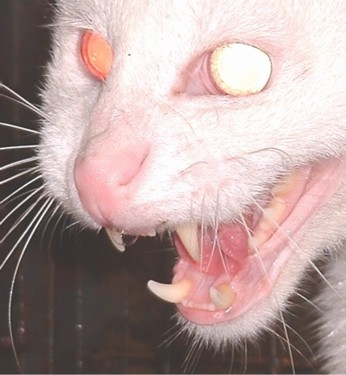
The Leopard Cat inhabits the forests and plains of the Indian subcontinent, Malay peninsula, Philippines, Indonesia and there are small populations in China. It is similar in size to the domestic cat, but has longer legs. It ranges from pale yellow, to golden yellow, reddish or greyish yellow and has large, solid, black spots and blotches over the entire body; the spots on the neck and back often join up into short stripes. Their under belly and underside of their face is white. Pink-eyed albino Leopard cats also occur (photographed 2002, by Musa Kiana, Chelmsford, UK). They prey on small mammals including small deer, birds, reptiles, fish and domestic poultry. They have been hybridised to create the popular Bengal breed and the Amur subspecies ("Amur Forest Cat") of Russia is believed to have hybridised naturally, giving rise to the Ussuri domestic breed (itself very rare due to breeding with other domestic varieties).
Tsushima Cat (subspecies)
The Tsushima Cat is a recently identified subspecies of Leopard Cat. It lives in forests on the mountains of Tsushima, a small island between Japan and Korea. It is considered to be the same subspecies as the Manchurian subspecies of Leopard Cat, except just a little darker in coloration.
Marbled Cat
(Pardofelis marmorata)
The Marbled Cat inhabits the forests of southeast Asia, from northern India, Malay peninsula, Sumatra, and Borneo. They resemble the Clouded Leopard, having thick soft fur with a similar clouded pattern. The background colour is golden, the large spots fade off to one side. Like the Clouded Leopard, they have very long canine teeth. Though the head resembles that of small cats, it is closely related to the big cats. Little is known about the marbled Cat's habits. They are probably mainly arboreal (deduced from their short legs, long thick tail and structure of the feet), preying on squirrels, fruit bats, birds, reptiles and frogs.
Margay
(Leopardus wiedii)
The Margay inhabits tropical rainforests in Mexico, Central America, and South America east of the Andes mountains. They resemble small Ocelots, having large black spots on a golden background, but are only half the size. The Margay has a short rounded head, very large eyes and a very long tail to provide balance. Their are arboreal and can rotate their ankles around 180º in order to descend trees head first (most cats must descend backwards). They prey on rodents, monkeys, lizards, birds and tree frogs. They breed poorly in captivity, but this has not stopped them from being popular exotic pets and they have been hybridised with domestic cats to create the "Bristol" breed (now extinct). They have also been hybridised with Ocelots, creating "Marlots".
Ocelot
(Leopardus pardalis)
The Ocelot inhabits the forests and scrublands of Mexico, Central America, and northeastern South America. They range from light yellow, to gold, reddish grey or greyish gold with black spots and stripes along their sides and face, and rosettes on their back. They are twice the size of the similar-looking Margay and prey on deer, peccaries (forest pigs), monkeys, snakes, and small rodents. They have been hybridised with Margays in captivity to create "Marlots" and there is a documented case of several litters of Ocelot-Puma hybrids in captivity. There have been unsuccessful attempts to create Ocelot/domestic hybrids.
|
Ocelots at Amazon World, Isle of Wight |
|
|
|
|
Oncilla / Tiger Cat / Little Spotted Cat
(Leopardus tigrinus)
The Little Spotted Cat/Oncilla inhabits wooded regions of Brazil, Argentina, Venezuela, Guyana, Surinam, French Guiana, Colombia, Peru, Paraguay, Ecuador and Uraguay, but is rare throughout its range. It is generally smaller than the domestic cat, with larger males reaching only 6 lb (2.8 kg). They are the smallest of the three cats in the genus Leopardus, the other members being the Ocelot and Margay. They have thick, soft fur that is a yellow ochre colour with black blotchy spots, black-ringed tail and paler facial markings. Melanistic (all-black) forms are relatively common. They prey on small animals like birds and rodents. Although diminutive, they are highly aggressive. Oncillas have been kept as exotic pets and have been crossed with domestic Abyssinian cats in captivity; the hybrids were not developed into a breed.
Pallas' Cat / Manul
(Otocolobus manul)
Pallas' cat inhabits the rocky steppes of the Caspian Sea area, Iran, China, Russia, Mongolia, Tibet, and Kazakhstan. It is about the size of an average domestic cat. Their resemblance to grey-tabby Persian Longhairs meant they were once wrongly believed to be the ancestors of Persian cats. Pallas' Cat has a very short broad head, very small round low-set ears, large yellow eyes and a heavy-set body on stocky legs. They have the longest coat of any species of wild cat; this is greyish with white tips to the hairs. They have small black spots over their body and head, and two black bars on the sides of their face. Pallas' Cats prey on pikas, marmots and small mammals, relying on sight to locate prey. They fall prey to toxoplasmosis contracted from their prey and poison used to control pikas. There are reports of Manul hybridising with domestic cats, but none have been authenticated.
Pampas Cat
(Oncifelis colocolo)
The Pampas Cat ranges along the south-western (but not coastal) area of Chile, Ecuador, Peru, Brazil, Paraguay, Bolivia, Argentina and Patagonia in South America. They are found in grasslands (pampas), forests and high altitude regions. They have broad faces, pointed ears, long hair, a small mane down their backs and bushy tails. When frightened, they fluff up their manes and tails to make themselves look larger. There are three main colour forms, these being found in different parts of the pampas Cat's range. The silvery-grey form has reddish bands running over its legs and body; this also produces some melanistic individuals. The red form has black bands on the legs. The paler tan form has spots on the back and stripes on the legs. They prey on guinea pigs and ground dwelling birds and will take poultry. Little is known about their habits and they are reported to be aggressive and not amenable to taming.
Rusty Spotted Cat
(Prionailurus rubignosus)
The rusty spotted cat inhabits the forests and mountains of Sri Lanka and the scrublands of India. It is one of the smallest felids, being similar in size to the Black-Footed Cat. As its name suggests, it is rusty coloured. It has dark brown spots on the back and rusty coloured spots on the paler underparts. The head is rounded with huge eyes and small ovular ears set obliquely on the top of their head. It is long-bodied with short legs and a very long, thick tail. It is believed to prey on mice, rats and birds and can be found around human habitations. If taken young enough, they can make good house cats. They are reported to hybridise with domestic cats around villages, but this has not been authenticated.
Sand Cat
(Felis margarita)
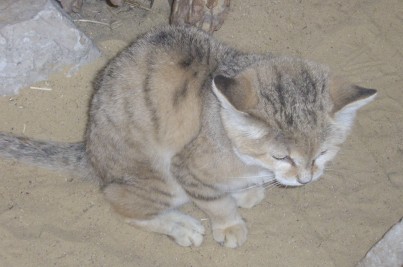
The Sand Cat inhabits the arid regions in the Middle East. There are five distinct populations: two in the Sahara desert of northern Africa, one in southern Saudi Arabia, one around the Caspian Sea in Russia, and one in Pakistan. It is a very small, short-legged cat with a very large wide head, and huge low-set ears. The dense soft fur ranges from sandy to light grey, with bands of dark brown to black around the leg, dark mascara lines and black tabby markings on the face and body. The pads of the feet are thickly furred to protect against hot sands. It is nocturnal and its large ears, which aid cooling, enable it to locate prey. Prey includes jerboas, lizards, rabbits and birds. They are adapted to getting most of their water requirements from their prey. They are preyed upon by venomous snakes, birds of prey, wild dogs and humans (for sport, for pets and for pelts). The encroachment of humans and domestic cats and dogs further endangers them.
Serval
(Leptailurus serval)
The Serval inhabits the plains and forests of Algeria and Morocco, central and southern Africa (excluding the southern-most tip and the rainforest belt in central Africa). It has a relatively small head with huge rounded ears set on top of the head and almost touching each other at their bases. The tail is very short. They are yellow-buff in colour with black markings all over; the markings comprise bars on the chest and legs, spots on the body, and tabby stripes on the face. It is sometimes called the Poor Man's Cheetah as it is long-legged, small-headed and similar in colour. Servals in the grasslands have larger spots than those from forest regions. A colour form peppered with numerous small spots is known as the Servaline and was once believed to be a separate species. Melanistic (all-black) servals are found at higher elevations and on the borders of rainforests. White servals exist in captivity; these are white or creamy colored, often with a lilac tint, with normal and pale spots. Servals rely on their keen hearing to locate prey such as small rodents, birds, young antelope, and lizards and make spectacular pounces. Servals are preyed on by leopards, dogs and humans. In captivity they have been crossed with Caracals to create Caravals and Servicals as exotic hybrid pets. They are hybridised with domestic cats to create the Savannah breed; in addition to black-spotted golden hybrids, breeders also replicate the melanistic and albino forms by using appropriately coloured domestic cats in the breeding programme.
|
|
|
European Wild Cat (including African Wild Cat, Indian Wild Cat, Scottish Wild Cat, Domestic Cat)
(Felis silvestris)
There are three distinct races of European wild cat. The African wild cat (Lybica group) is found throughout Africa (excluding Western African rainforest) and the Middle East. It inhabit the mountains, plains and woods and the Northern African form is the ancestor of modern domestic cats. The European wild cat (Silvestris group) inhabits coniferous and deciduous woodlands throughout Europe (excluding Scandinavia). The Indian wild cat (Ornata group) inhabits semi-desert and steppe regions of the Middle East, India, Russia and China. The Domestic Cat, a subspecies of European Wild Cat, is found throughout the world due to human intervention and will interbreed with any of the F silvestris subspecies, resulting in mongrel populations.
African Wild Cat
The African Wild Cat is generally lighter coloured than the European Wild Cat and has two main colour forms: steely grey (forest forms) and greyish tan (arid regions). The ground colour is generally sandy, yellow grey, greyish brown or dark grey. It has darker mackerel tabby markings that ranges in intensity and pattern. It eats rodents, insects, birds and small mammals.
European Wild Cat
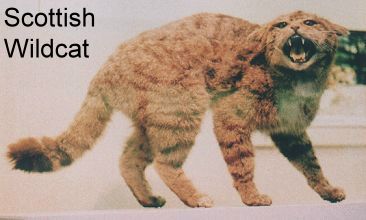
The European Wild Cat has thicker, darker fur than the African Wild Cat. It is slate grey to mid brown, with dark tabby markings. It has a broader head than modern domestic cats and a blunt-ended tail. Black individuals are mostly due to hybridisation with domestic cats; though there has been a confirmed melanistic Scottish Wildcat. There are probably few pure Scottish Wild Cats left except in isolated areas; most populations have bred with domestic cats from farms resulting in tapering tails and white patches. European Wild Cats prey on small rodents, but will also take birds and small reptiles. Scottish Wild Cats prey largely on rabbits and hares. It is deliberately hybridised with the Chausie (a Jungle Cat hybrid) to create the Euro-Chausie and also with the Jungle Cat species to create the Euro-Chaus.
Indian Wild Cat
The Indian Wild Cat living in the eastern parts of their range tend to be smaller. They have a light sandy ground colour with brown spotted markings, which sometimes converge into stripes along their backs. The spots are broken stripes rather than true spots. They prey on rodents, but will also take hares and birds. A number of "Indian Cats" (possibly hybrids between Indian Wild Cats and domestic cats) were imported into Britain in the late 1800s and resembled the Abyssinian Cat with ticked body and barring on legs and tail.
|
MESSYBEAST : SMALL CAT HYBRIDS, BRITISH BIG CATS & PREHISTORY |
You are visitor number